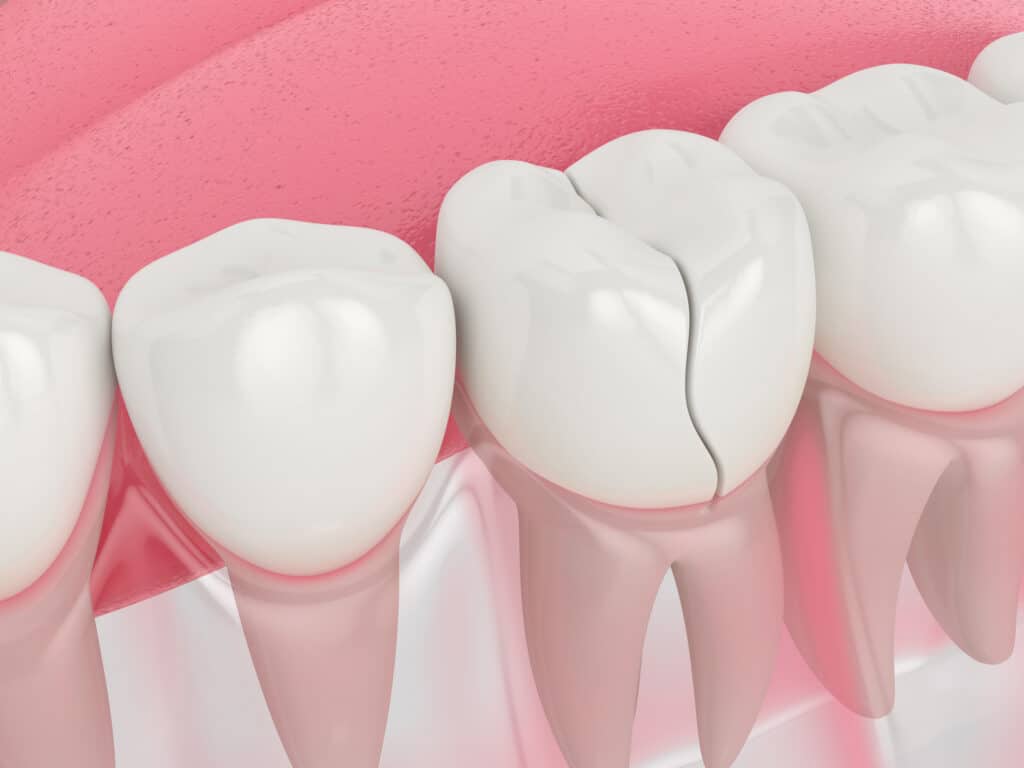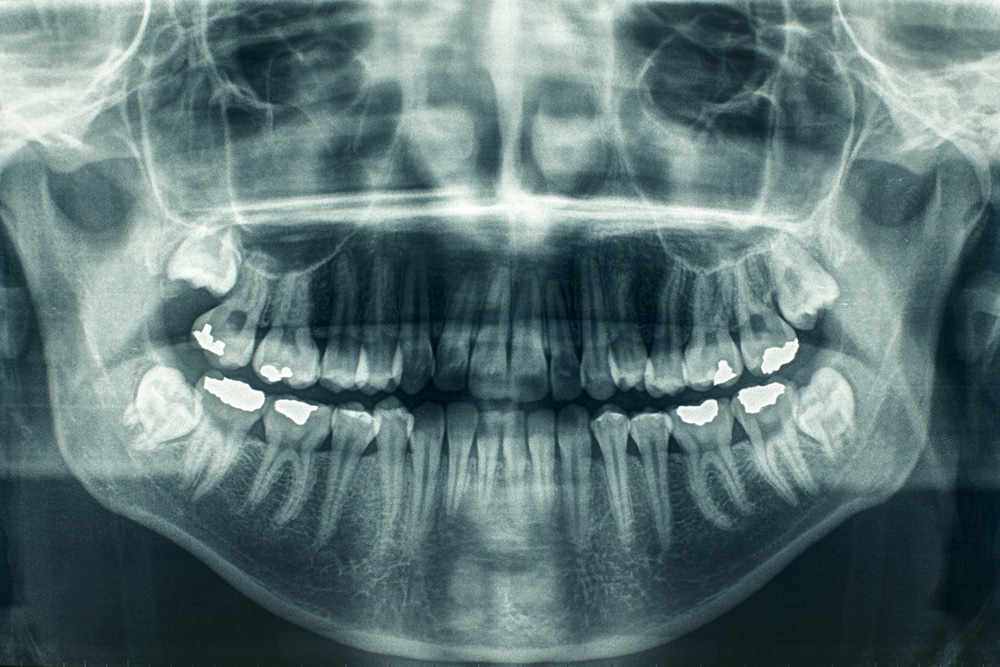If you’re experiencing tooth pain, or you feel like your tooth is loose, you may have cracked tooth syndrome. What is cracked tooth syndrome? Let’s take a closer look at this condition, and what you can do about it.
What is Cracked Tooth Syndrome?
Cracked Tooth Syndrome (CTS) is a dental condition in which a tooth has a crack, fracture, or fissure, which may be too small to be detected visually. There are many different types of cracks that might be affecting your teeth, or affecting different parts of your teeth. There are also remedies to this condition, as well as symptoms that can help you identify cracked tooth syndrome.
Symptoms of Cracked Tooth Syndrome

If you don’t see any cracks in your teeth, it can be hard to identify whether or not you have a cracked tooth. Look for these symptoms and risk factors, which can indicate you’re experiencing cracked tooth syndrome:
- Pain while chewing
- Sensitivity to hot or cold foods
- Sensitivity to sugary foods
- Sharp or throbbing pain throughout the day
- Feeling a tooth is loose
- You’ve experienced multiple cavities or other weaknesses in your teeth
- You’ve experienced a heavy impact to your mouth or jaw
- Teeth grinding or bruxism has been a problem
- You’ve experienced nutritional deficiencies or eating disorders
- You’ve recently had a dental restoration, such as a filling
Types of Cracks in Your Teeth
If you’re experiencing pain or tooth sensitivity, you might inspect your teeth for cracks or chips. In some cases, the cracks might be visible to the naked eye. Or, these cracks can be very fine, and may require help from a dentist or endodontist to diagnose. There are different types of cracks that can occur in a tooth, and they vary in severity. Here are a few that might occur:
- Craze lines: Small, thin cracks, sometimes called craze lines, may appear on the outer enamel of your tooth. Craze lines are usually very fine and don’t cause pain. However, if craze lines deepen, they can expose the softer parts of teeth and cause sensitivity or pain.
- Fractured cusp: A crack that appears near a dental filling is called a fractured cusp. This can occur from an injury or other usual causes, but it can also be caused by improperly fitted dental fillings or other restorations.
- Split tooth: When a deep crack occurs from the tooth’s crown through the root, it may completely fracture your tooth into two separate parts. This is called a split tooth.
- Vertical root fracture: These cracks occur in the root of the tooth and often extend vertically from the root up into the crown. These fractures can be challenging to diagnose, since vertical root fractures may not cause symptoms unless your tooth becomes infected.
Cracked Tooth Syndrome Causes
Now that we know what cracked tooth syndrome is, what causes it? Understanding the causes of cracked tooth syndrome can help you prevent and avoid cracks in your teeth.
There are many different causes of cracked tooth syndrome. Some of these are direct causes, and some of these are adjacent issues that can weaken teeth and make them more susceptible to cracks.
- Heavy impacts: If you’ve been hit or struck in the mouth or jaw, this force can cause your tooth to crack.
- Ill-fitting dental restorations: If dental restorations, like fillings, aren’t placed properly, they can cause too much strain on teeth, and cause them to crack.
- Teeth grinding: Teeth grinding puts constant, intense strain on teeth. If this issue isn’t resolved, it can cause cracked tooth syndrome.
- Nutritional deficiencies: Just like the rest of your body, your teeth need nutritional support to stay strong. If you’re suffering from nutritional deficiencies, your teeth may weaken, and be more likely to crack.
- Eating disorders: Eating disorders can contribute to nutritional deficiencies, and can introduce stomach acid to teeth, which can wear them down and weaken them, making them more likely to crack.
- Tooth decay: If tooth decay goes untreated for too long, the acids from bacteria will begin to eat away the softer structure of teeth, underneath the enamel. As the tooth weakens, it’s more likely to crack.
Diagnosing CTS
Diagnosing and treating CTS can be challenging, because the cracks are often difficult to detect. Finer cracks may produce few symptoms, or symptoms may come and go, while larger cracks generally produce more extreme symptoms.
Dentists may use various diagnostic methods, such as transillumination (shining a light through the tooth), using dental dye or a special staining solution. Your dentist might also use a fine probe to run over the tooth and find any points where the probe catches over the smooth surface, which can uncover where cracks exist.
Dentists may also take a detailed inventory of your symptoms to rule out other potential problems, and hone in on a cracked tooth syndrome diagnosis. This can be challenging, since multiple dental issues may exist at once. For example, if decay has weakened your teeth, you may have untreated cavities as well as cracked tooth syndrome. Untreated cavities can also result in tooth infections, which can also cause pain and discomfort.
Treating CTS
If you’re experiencing tooth pain and sensitivity, there are a few methods you can try to reduce your symptoms. You should make an appointment with your dentist or orthodontist as soon as possible, but these at-home treatment methods can help in the meantime:
- Ice packs: Though ice and cold foods can cause tooth pain, using ice packs on your jaw can help to relieve pain.
OTC pain relievers: Over-the-counter pain relievers like acetaminophen (used in Tylenol), ibuprofen (used in Advil), or naproxen (used in Aleve), can help with tooth pain. - Local anesthetics: Products that contain benzocaine, including brands like Orajel, cause temporary numbness and can help relieve tooth pain. However, these products should be used only with great care, since they have been associated with rare, but potentially deadly blood disorders.
- Avoid certain foods: If especially hot or cold foods irritate your teeth, avoid these as much as you can.
- Chew with care: Avoid chewing on the side of your mouth that hurts. Furthermore, avoid crunchy, tough, sticky, or chewy foods that can further damage or irritate your teeth.
- Salt water rinse: Rinsing your mouth with salt water can help to reduce irritation and pain.
- Orthodontic wax: Covering the affected tooth with orthodontic wax can help to reduce sensitivity and pain, since it covers the crack and helps to protect the softer tissues within your teeth.
Professional treatment for cracked tooth syndrome depends on the severity and location of the crack. Some interventions are relatively simple, while more serious cracks will require more serious treatments.
- Bonding: Cracks on the crown of teeth can be treated with plastic resin, which is used to fill in the fracture.
- Cosmetic contouring: Minor cracks can also be treated by rounding and polishing, which smooths out the cracks in the tooth.
- Crown: As long as the tooth root is intact, a porcelain or ceramic cap can be fitted over the fractured tooth.
- Veneer: For minor cracks, a thin covering of porcelain or plastic can cover the front of the tooth.
- Extraction: If the tooth is completely split, extraction may be necessary, since the tooth isn’t healthy enough to withstand repairs. However, the tooth can be replaced with dental implants.
- Root canal: When the fracture extends into the pulp, your dentist can remove the damaged pulp to prevent further tooth weakening. This can help to repair the tooth and prevent tooth loss.
It’s essential to address cracked tooth syndrome promptly, as untreated cases can lead to further complications, such as infection and the loss of the affected tooth. If you suspect you have a cracked tooth or are experiencing any of the symptoms associated with CTS, consult a dentist right away.


